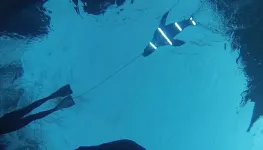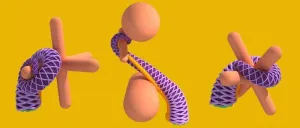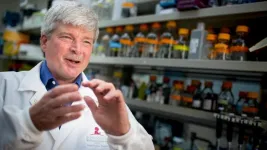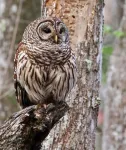(Press-News.org)
AMES, Iowa – In their long strings of nucleotides, DNA molecules hold massive troves of genetic data providing instructions for how living organisms should function – the blueprint of life. How the blueprint is stored, however, impacts how it is read and used.
As cells divide and replicate, DNA strands coiled around proteins – chromatin – are in tightly bundled chromosomes. After division, the chromosomes loosen and chromatin is less compact. How and where the chromatin fiber folds and loops onto itself affects what genes are activated. Findings from an Iowa State University-led research team offer new insight into this process that may have potential biomedical uses.
“The three-dimensional structure of the chromatin when it’s folded matters for gene regulation. Where chromatin physically sits in the nucleus matters. The evolution of chromatin folding patterns alters genome function and developmental programs that drive phenotypic evolution and adaptation to changing environments,” said Nicole Valenzuela, professor of ecology, evolution and organismal biology at Iowa State University. “Chromosome folding remains a bit of a black box. We’ve learned a lot about it, but it’s still just the tip of the iceberg.”
The shape and location of chromosomes during the post-division interphase of the cell cycle impacts gene function because it brings non-adjacent regions into contact, such as enhancer sequences and gene promoters. DNA readily available for interaction within active chromatin regions is more likely to be expressed, whereas DNA within less accessible repressed chromatin is silenced.
By analyzing how often different parts of DNA molecules contact each other, scientists have modeled the varying physical configurations of the chromatin in humans and many commonly researched animals, including mice and birds. Add turtles to the list, thanks to a research team Valenzuela helped lead. In a recent paper in Genome Research, the researchers described their study of the genomes of two species of turtles, which showed a surprising chromatin arrangement that hasn’t been observed in other organisms.
A novel alignment
Chromosomes have a thinner junction point called a centromere and at their ends are protected by repetitive sequences of DNA called telomeres. In humans, chromosomes remain in separate territories inside the cell nucleus. But in the cells of some animals, like marsupials, chromosomes cluster so their centromeres can interact. In other animals, like birds, they cluster so telomeres are in contact. Turtles are the only animal studied so far where telomeres and centromeres are aligned to be near each other. These differences in folding and position translate into lineage-specific gene regulation.
“It’s possible this is the ancestral condition of amniotes, from which mammals, birds and reptiles evolved in different patterns. The turtles may be showing us what existed at the beginning, shedding light on the evolution of vertebrate genomes,” Valenzuela said.
Learning more about the three-dimensional genome structure of turtles and how it responds to environmental conditions could help explain the genetic basis of traits that could be leveraged for biomedical uses in humans. For instance, some turtles can survive weeks without oxygen, which could lead to treatment of strokes. Figuring out how some turtles can withstand extreme cold could benefit cryogenic preservation of human tissues.
“We want to understand more about why different lineages are different in some aspects and why they’re the same in others, what parts we share and what parts differ,” said Valenzuela, whose research focuses on turtles. “If we can reconstruct the evolutionary history of the changes that have taken place, we will be able to tell much more about how the differences in the packaging of the DNA and the folding of chromosomes might be affecting the traits we’re interested in, how genes are regulated and how vertebrate genomes evolve. And understanding how turtle chromatin structure responds to external conditions also will benefit conservation efforts by helping predict the potential effect of environmental change on their biology.”
The study was funded in part by two grants from the National Science Foundation.
Digging deeper
Studying the spatial organization of turtle genomes will continue to be an emphasis for Valenzuela’s lab, she said.
Future plans include examining additional turtle species. The current study concerned the spiny softshell and northern giant musk turtles, but Valenzuela’s research group has already collected the data to look at the genomic structure of four more species of turtles. She’d also like to compare turtles to crocodiles, lizards and snakes to see if their chromatin arranges in similar patterns.
To dig deeper on the function of turtles’ chromatin folding, Valenzuela will study the liver organoids her lab developed for three species of turtles – tiny, lab-grown balls of cells that mimic a simplified version of liver tissue.
More sophisticated mapping methods also will yield richer results, including higher-resolution data that produces even more detailed chromatin maps and techniques for studying how the 3-D chromatin structure changes over time and in different environments.
“To really do genotype-to-phenotype mapping, we have to get to this level of complexity,” she said.
END
Adolescents who meet the recommended guidelines of nine to 11 hours of sleep per day were shown to have a significantly lower risk of hypertension, according to a new study from UTHealth Houston.
Recently published in the Journal of the American Heart Association, the research revealed that adolescents had a 37% lower risk of developing incidents of high blood pressure by meeting healthy sleep patterns, and underscoring the importance of adequate sleep behavior. The research further explored the ...
How would you summarize your study for a lay audience?
T helper (TH) cells are essential immune cells that help other immune cells function effectively. When activated in response to environmental stimuli, these cells can differentiate into either TH1 cells, which fight against viruses and intracellular pathogens, or TH2 cells, which fight against extracellular pathogens like bacteria and parasites. However, scientists haven’t fully understood whether infected tissue itself has any role in directing the optimal T cell differentiation in response ...
Current guidelines recommend that pregnant people receive a vaccine against respiratory syncytial virus (RSV)—which typically causes mild, cold-like symptoms in most adults but can be deadly for infants—during weeks 32–36 of pregnancy. New research led by investigators at Mass General Brigham suggests that vaccination earlier in that timeframe, closer to 32 weeks, could provide the best protection for newborns against RSV. The findings are published in the American Journal of Obstetrics & Gynecology.
“Receiving ...
Surfers could be protected from future shark attacks following new discoveries about how to trick sharks’ visual systems made by Professor Nathan Hart, head of Macquarie University’s Neurobiology Lab, Dr Laura Ryan and colleagues.
Hart, Ryan and their co-authors of a new paper in Current Biology titled Counterillumination reduces bites by Great White Sharks say their work “may form the basis of new non-invasive shark deterrent technology to protect human life”.
These researchers previously discovered that great whites place a high reliance ...
Embargoed for release until 5:00 p.m. ET on Monday 11 November 2024
@Annalsofim
Below please find summaries of new articles that will be published in the next issue of Annals of Internal Medicine. The summaries are not intended to substitute for the full articles as a source of information. This information is under strict embargo and by taking it into possession, media representatives are committing to the terms of the embargo not only on ...
LOS ANGELES — Alcohol use increased during the COVID-19 pandemic and remained elevated even after the pandemic ended, according to a large nationally representative Keck Medicine of USC study published today in the Annals of Internal Medicine.
From pre-pandemic (2018) to the height of the pandemic (2020), heavy alcohol use among Americans rose by 20%, and any alcohol use rose by 4%. In 2022, the increases were sustained.
The rise in drinking was seen across all age groups, genders, race, ethnicities and regions of the country, except for Native Americans and Asian Americans. Adults ...
Mechanical engineering PhD candidate Arman Tekinalp, fellow graduate student Seung Hyun Kim, Professor Prashant Mehta, and Associate Professor Mattia Gazzola, all from the Department of Mechanical Science and Engineering at the University of Illinois Urbana-Champaign, recently published in the Proceedings of the National Academy of Science (PNAS). Their interdisciplinary collaboration also included Assistant Professor Noel Naughton (formerly a Beckman fellow) from the Department of Mechanical Engineering at Virginia Tech alongside researchers from the Department of Molecular and Integrative Physiology at Illinois ...
Microplastics, plastics smaller than 5 millimeters, are littered across the world, contributing to global warming, disrupting food chains, and harming ecosystems with toxic chemicals. This is why Dr. Manish Shetty is working to break down plastics before they can get into the environment.
Creating sustainable chemicals and developing better waste management will contribute to better sustainability. This research is part of figuring out how to make green hydrogen available for waste management using catalysts.
Shetty’s research uses solvents in low amounts that also act as hydrogen sources to break down a specific class of plastics called ...
(MEMPHIS, Tenn. – November 11, 2024) There are processes in the human body that can suppress the growth and proliferation of cancer cells. These mechanisms, including those involving the tumor suppressor protein p53, are widely studied due to their critical role in disease. Through studies of proteins that regulate p53, scientists at St. Jude Children’s Research Hospital have uncoupled a previously unrecognized tumor suppression mechanism. Usually found at low levels in cells, the p14 Alternative Reading Frame protein (p14ARF) is expressed at higher levels under oncogenic stress and activates ...
Baton Rouge, November 4, 2024 – Novel research just published in the American Ornithological Society journal, Ornithological Applications, has revealed noteworthy insights into how Barred Owls (Strix varia) interact with urban environments, with implications for both wildlife conservation and urban planning. This study, conducted by a team of biologists from Louisiana State University and other institutions, highlights the connection between owl habitat selection and an urban landscape, underscoring the ...




